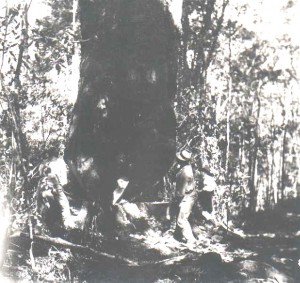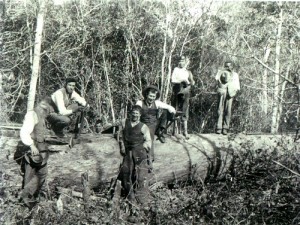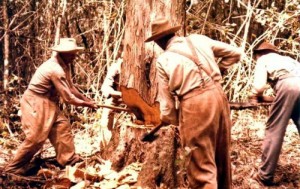 The Knysna Woodcutters
The Knysna Woodcutters
This narrow coastal strip of indigenous forest in the Southern Cape, was the main source of income for generations of woodcutters, Knysna being the principal town as far as the timber industry was concerned. Until well into the 20th century the entire economic life and structure of Knysna revolved around the timber trade.
In 1711, the eastward movement of the Dutch colonists facilitated the search for timber when news of vast forests in the area was related to the authorities in Cape Town. The inaccessibility of the area handicapped trade, but after the completion of a road from Swellendam and the establishment of an official ‘timber post’ in 1772, the situation improved somewhat and there was a gradual influx of settlers who made their living from the forests. The founding of towns in the Cape interior during the 19th century increased the demand for wood used in the construction of buildings, and the trade also benefited from the Great Trek which created a larger market for ox wagons. The discovery of diamonds in Kimberley 
Many of the newcomers to the area were evicted ‘bywoners’ from the arid Karoo districts. These districts experienced a severe economic crisis after the ostrich feather slump of 1913-14 and a crippling drought in 1916. The forest and coastal belt was a haven for such ‘poor whites’ from the Karoo. The forestry settlements were started during and shortly after the First World War as relief schemes for the urban unemployed and the rural casualties of drought.
The majority of ‘poor whites’ in the area found themselves outside the plantation settlements. They constituted the bulk of the woodcutting population and were largely dependant on the indigenous forests for their livelihood. Many of them viewed the forests as a providential gift “God het ons arm mense die houtjies gegee”, one woodcutter expressed this general sentiment.
However, the work the woodcutters performed and the conditions under which they toiled were most arduous.
After his spell in the forest, the woodcutter came home to little more than a corrugated iron or wooden shack, consisting of two rooms with a clay floor and a kitchen. His often large family meant overcrowded living conditions, lack of hygiene and often insufficient food. In general the woodcutter families lived an isolated and insular life, cut off from ‘civilising’ influences and attached to the forests and their particular life-style. The woodcutters were self-employed, willing and able to work, but often lacked the necessary capital, training and most important, the opportunity to benefit from their labours.
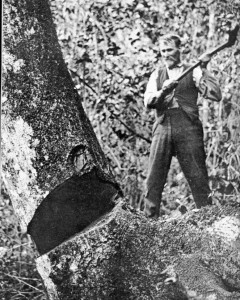
By far the most prominent amongst the timber merchants was the firm of Thesen and Company. The Thesen family came to South Africa in 1869 from Stavanger in Norway while en route to New Zealand. In Cape Town, they came into contact with the Swedish-Norwegian consul and merchant, C.A. Akerberg, who informed them about the shortage of ships along the South African coast. Akerberg put Arnt Thesen in touch with some Cape merchants who wanted cargoes delivered along the coast, including the port of Knysna. Knysna, reminiscent of Norway, at the time a small town of approximately 200 whites, appealed to the Thesens. But more importantly, the economic potential of the large forests close by attracted them and in April 1870 the family decided to settle in Knysna.
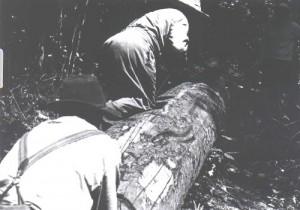
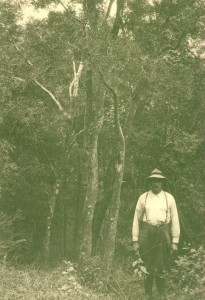
The established timber merchants had a virtual monopoly over the timber trade, and went to great lengths to protect their dominance. There were considerable profits to be made in the timber trade and the accumulation of great wealth was held by the timber merchants, but this was not achieved without its casualties. Much of this wealth was at 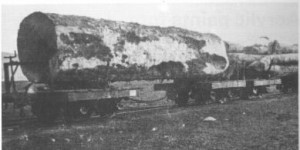
Despite the debilitating effect of merchant capital on the woodcutter population, the woodcutters still preferred to continue work in their beloved forests with a very small income – but as independent operators. ‘Forest workers love the forest and are proud of the fact that they are not daily-paid men. That is the one thing which still makes them strong in the midst of poverty,’ A.J. Werth stated in 1939.
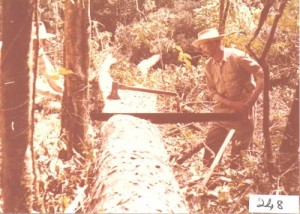
The final demise of the woodcutters came in 1939 when the number of those registered had dwindled to 256. Through the Woodcutters’ Annuity Act of that year they were granted an annual annuity and at the same time forfeited the right to work in the forests. This act, A.J. Werth noted in parliament in 1939 ‘ was the end of a chapter of history in those parts, and it terminates an old established settlement of people. They are an interesting class of people with a highly developed sense of independence and self-respect….’
The contours and context of their lives and work were shaped by potent forces which in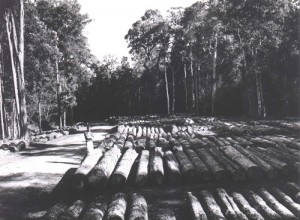
“Their work, be it felling, slipping or sawing is laborious in the extreme,” a sympathetic observer wrote in 1911, “hard, rough, exhausting work, for the most part in a damp cold forest where the rainfall is excessive, where the paths are pools of mud and slush, where the undergrowth is forever damp and wet, where the sun is forever hidden. In sweat sodden clothes they toil and sleep and toil. A more fatiguing work, a more unhealthy occupation cannot be imagined. It is often in the most inaccessible places that the woodcutter has to conduct operations: along the slopes of steep mountains, in the bottom of deep kloofs, he has to fight his battle with the sturdy, unmanageable monsters of the woods. To see a heavy log slipped out of a deep gully and dragged to the saw pit, inch by inch, by long teams of crawling, groaning oxen, along slippery, slushy, almost impassable slip paths, is a never to be forgotten sight.”
Excerpts from “The Making of Class” “God het Ons Arm Mense Die Houtjies Gegee”:
Towards a History of the ‘Poor White’ Woodcutters in the Southern Cape Forest Area
circa 1900-1939
Thesis by Prof. A. Grundlingh
Photographs courtesy of Millwood Museum, SanParks, Department of Forestry
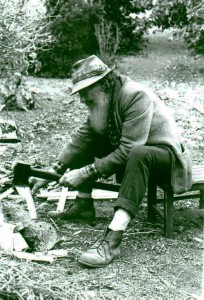 The Knysna Woodcutters
The Knysna Woodcutters